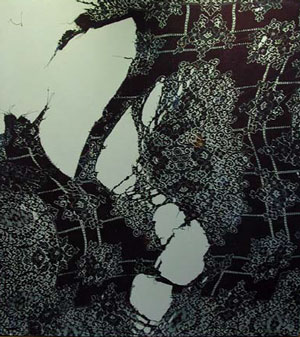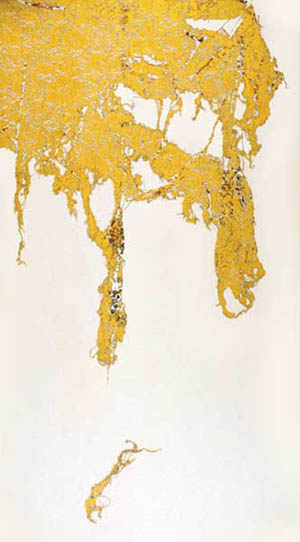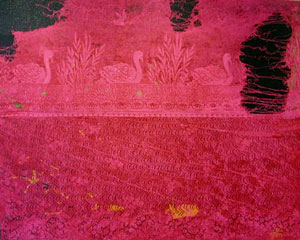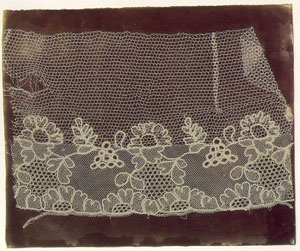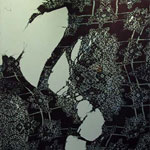If you’ve been following the work of Mark Flood for any of the last couple of decades, you might think that you’ve walked into the wrong show. The stark contrast between his new lace paintings and just about anything else you’ve seen by him before will have you stepping back outside to double-check the address on the building.
Long a respected member of the Houston art community, Flood’s art is best known for its adroit institutional critique, particularly when it comes to pop culture or the politics and practices of the art world. His work has been described as “difficult” and “challenging” (in the best sense of those words) but rarely aesthetically pleasing (in the typical sense of the phrase). But these paintings are different. Gone are the overt confrontation, aggressive irony, and punk rock sensibility of previous work (and perhaps he”ll even take some knocks for that from some quarters). In their place are beautiful pictures. So beautiful that I bet your mom would even like them.
At first blush viewing these paintings can be a bit like taking a bite of Proust’s famous madeleine producing an onrush of associations, sometimes nostalgic, sometimes exotic, sometimes frivolous: grandmothers” doilies, the veils of harem dancers, or even the pop queen of lace, Stevie Nicks. Several of the paintings are suggestive of coastlines from LANDSAT images, others evoke the opulent decay of New Orleans or Bram Stoker. Their shapes are evocative too as the titles themselves suggest: Shipwreck, Magnet, Mask, Dragonseed. Nonetheless these paintings aren’t about lace and its many connotations. That’s the baggage we bring. For the artist, lace is a serendipitous painting device.
Flood’s process has been evolving over the last three years, the lace first appearing as a background element and gradually becoming the dominant motif. The surprise is that there are no collaged elements. It’s just paint. The lace is long gone. The paintings are created by tearing, shredding, or otherwise torturing the lace, soaking it in paint, and carefully arranging it across the canvas: a fold here, a scrunch there, a few loose threads holding the tattered remains together. Most are dominated by two colors intentionally chosen by Flood from daily life and nature instead of a Pantone or Liquitex color chart. Here and there other colors are introduced, sometimes to accentuate the color contrast and other times as a seemingly deliberate attempt to blemish an otherwise too perfect painting — a wine stain on The Cygnets, some sunspots on Field of Flowers. The moment of truth comes when Flood peals away the lace, a process he compares to peeling away the gooey pull-tab of old Polaroids. And like an impromptu Polaroid, the secret ingredient is chance: sometimes you capture that magic moment and sometimes you’ve just taken a picture of someone with their eyes closed and their mouth full of food. Fortunately, Flood is a good editor: there are few if any also-rans in the bunch.
The results are sometimes reminiscent of earlier abstract and non-objective painters. However, the pictorial content of some of the lace — birds, flowers, seashells — and the material’s loaded content would have devotees of these earlier schools shouting apostasy from their graves. It’s just as well, as such a reading is a red herring anyway. When asked, Flood mentions Alberto Burri, Lucio Fontana, and Bruce Conner amongst those whose work he admires; but again let’s resist the temptation to simply leave it at that. Flood is not interested in picking up where any of those artists left off. This isn’t emulation and it’s not an art history lesson. Flood’s just making beautiful pictures and enjoying himself while he makes them.
But perhaps he hasn’t quite given up the ghost. Maybe these paintings can be sincere (read: non-ironic) and still relate to Flood’s earlier work and its agenda. In the Invisible Dragon: Four Essays on Beauty, critic Dave Hickey argued nearly a decade ago that beauty — the unidentifiable something that allows us to derive pleasure from simply looking at pictures — has become an anti-establishment gesture, not necessarily against governments, corporations, or the predominant culture but against art world institutions. The basis for Hickey’s argument is that beauty (whatever it is) at some point became associated with the art market and therefore was a ‘soft” (read: suspect) criteria. The art bureaucracy, defining its role over the course of the 20th century as the arbitrators of art, cast suspicion on the pleasures of “beautiful” pictures, dismissing such a response as tainted by the marketplace, and proposed instead its own “tough” (read: legitimate) criteria of ideas. All this, Hickey concludes, to perpetuate their own jobs. How, he wonders, did we ever allow ourselves to internalize this suspicion and relinquish our delight to the parochial rigor of these bureaucrats? If, for the sake of argument, we accept Hickey’s position, it’s not difficult to see how this state of affairs might have arisen. After all, from the point of view of a curator or a critic, formal innovation, socio-political ideas, historical context, and artistic theory offer much more to discuss and write about than an intangible characteristic that changes with each beholder. Hickey’s view may seem a cynical one; but then again, what kind of cynic proposes beauty as a tool of subversion?
Whether Flood has adopted Hickey’s battle cry as his own is ultimately beside the point because he has arrived at the same conclusions. Specifically that it’s OK to make beautiful paintings that people like, that art doesn’t always need to be loaded up with ideas in order to be taken seriously, and it doesn’t require art world validation. In a way, Flood is re-discovering what paint can do and what a painting can be, not exactly re-discovering it for the world but re-discovering it for himself. Like English photography pioneer William Henry Fox Talbot, who captured the folds and frayed edges of lace directly on light-sensitive paper in the 1840s, Flood has found his breakthrough technique in the proverbial grandmother’s attic. The question is whether the art world in the ten years since Hickey’s Four Essays has found a place for beauty.
That an artist can make such an about-face in his work when so many beat the same drum year after year speaks well of both the artist and art itself. But maybe Flood is just mellowing in his middle age, hanging up his arsenal and giving the people what they want. Then again maybe he’s just found a better way to deliver his message right under our noses and onto our walls. On page 267 of Jon Savage’s England’s Dreaming, a chronicle of punk rock, is a picture of Johnny Rotten reading a newspaper. Is that lace he’s wearing?
Images courtesy the artist and Mixture Gallery.
Chris Ballou is a writer, curator, and KTRU DJ working in Houston.


